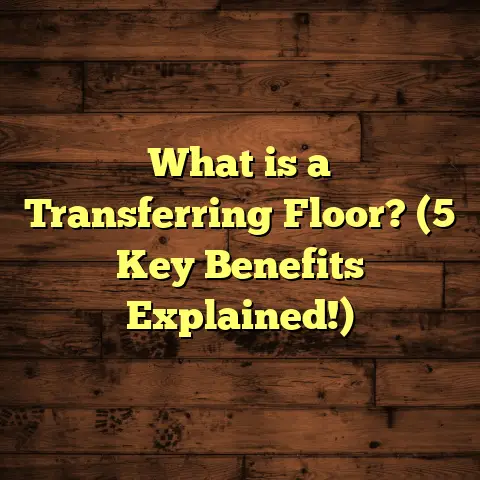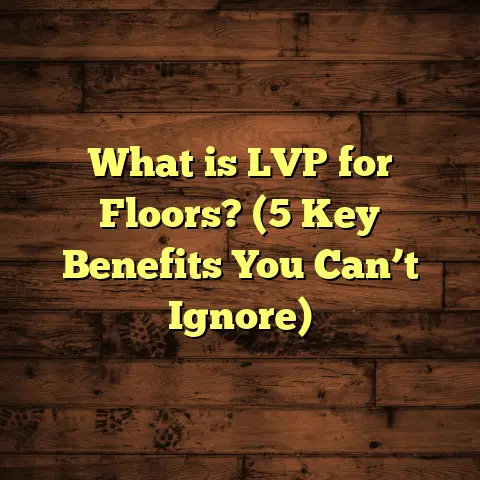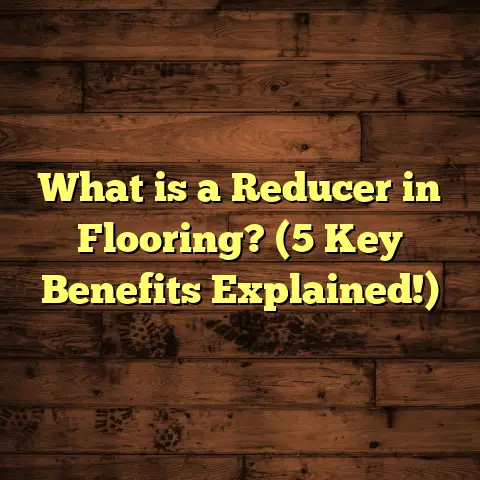What is Better: Carpet or Hardwood Floors? (5 Must-Know Facts!)
Imagine stepping barefoot onto a floor
that feels warm and soft under your feet—
a plush carpet cushioning every step,
inviting you to linger a little longer.
Now, think about walking on smooth hardwood,
cool and solid, with that unmistakable grain
and character that seems to tell a story.
Which one would you choose for your home?
I’ve spent years helping folks make that call,
and today, I want to share some insights from my experience
that might make your decision a whole lot easier.
What Is the Real Difference Between Carpet and Hardwood Floors?
At its core, the choice between carpet and hardwood comes down to the material beneath your feet and how it shapes your daily living experience. Carpet is a textile surface made from fibers such as wool, nylon, polyester, or olefin that are woven or tufted into backing material. It’s soft, flexible, and generally warmer underfoot. Hardwood flooring consists of planks of real wood—oak, maple, cherry, hickory—cut and finished to reveal the natural grain patterns and texture of the timber.
Both flooring types serve different purposes and fit different lifestyles. Carpet tends to create a warm, cushioned environment that absorbs sound and adds softness to a room. Hardwood floors offer durability, timeless style, and ease of cleaning but come with a cooler feel and firmer surface.
Let me break down five key facts I’ve learned over the years that really shape which one might be better for your needs.
1. Comfort and Feel Underfoot: Softness vs. Firmness
You might be surprised how much the feel of a floor influences your mood and everyday comfort. Carpets excel in this department. When I installed wall-to-wall carpet in a family’s living room once, their kids immediately kicked off their shoes and started playing on the floor for hours. The soft cushioning made it safe for their little tumbles and created a space where they felt cozy and relaxed.
Carpet fibers provide insulation from cold floors and reduce foot fatigue if you’re standing or walking for long periods. Wool carpets, for example, have natural warmth and resilience that synthetic fibers sometimes can’t match.
Hardwood floors are firmer and cooler, which can be refreshing in warm climates but less cozy in colder months unless combined with area rugs or radiant heating systems. Hardwood can feel luxurious and elegant but is not as forgiving on bare feet or joints.
According to a study by the American Society of Interior Designers, 68% of homeowners said carpet felt more comfortable in bedrooms and family rooms compared to hardwood or tile floors. This is especially true for people who enjoy barefoot living or have young children.
But there’s a downside. Carpets can trap allergens such as dust mites, pet dander, and pollen—something I’ve witnessed firsthand when installing carpets in homes with allergy sufferers. Hardwood doesn’t trap these particles as much and is therefore recommended for those with sensitivities.
If comfort is your priority, carpet is usually the winner here.
2. Durability: Which Lasts Longer?
When it comes to longevity, hardwood floors shine. I’ve restored hardwood floors in century-old homes that still look stunning after refinishing multiple times. Hardwood can handle heavy foot traffic, pets running around, and furniture moving without showing wear quickly.
Hardwood floors might dent or scratch—especially softer woods like pine—but sanding and refinishing can renew their appearance several times over the lifespan of the floor. In fact, a well-maintained hardwood floor can last 50 years or more.
In contrast, carpet wears out faster. The fibers flatten over time from foot traffic; stains can become permanent despite professional cleaning; edge wear near doorways becomes visible; odors may develop if spills aren’t cleaned promptly.
The Carpet and Rug Institute notes that average carpet life ranges from 5 to 15 years depending on fiber quality, density, installation method, and household conditions.
In homes with pets or kids who are rough on floors, hardwood’s durability often proves more practical despite the initial investment.
I remember working with a client who had two large dogs. They initially chose carpet thinking it would be softer for their pets but ended up replacing it within five years because of staining and wear. Switching to hardwood saved them money and stress over time.
3. Maintenance: Cleaning and Upkeep
Maintenance is often overlooked when choosing floors but plays a massive role in your satisfaction long-term.
Carpets demand more attention daily. Vacuuming twice a week is necessary to prevent dirt buildup deep in fibers. Stains need immediate treatment with spot cleaners or professional help. Many people underestimate how much dirt carpets trap—especially in homes with kids or pets.
Professional steam cleaning once or twice annually helps restore appearance but costs extra money and time.
Personally, I’ve had clients tell me their carpets started to smell musty even after regular vacuuming due to hidden moisture or spills they missed. That’s something you don’t usually worry about with hardwood floors.
Hardwood floors are much easier to maintain in everyday life—usually sweeping or damp mopping works well. No worries about trapping smells or allergens inside the material. However, too much water can damage wood; excess moisture causes warping or cupping if not dried quickly.
I installed hardwood in my kitchen five years ago, where spills are common. I just wipe up any mess fast and mop occasionally with a product made for wood floors. No deep cleaning machines needed.
Over time, maintenance costs for hardwood tend to be lower than carpet replacement or professional cleaning fees.
4. Cost: What About Your Wallet?
Cost is always part of the conversation when deciding between carpet and hardwood flooring.
Here’s a rough breakdown of typical costs per square foot (including materials and installation):
| Flooring Type | Material Cost | Installation Cost | Total Cost (per sq ft) |
|---|---|---|---|
| Carpet | $3 – $7 | $1 – $3 | $4 – $10 |
| Hardwood | $6 – $12 | $4 – $8 | $10 – $20 |
As you can see, hardwood generally has a higher upfront cost due to expensive materials and labor-intensive installation involving plank fitting and finishing.
I often use an online tool called FloorTally to get precise estimates based on local prices where I work. It factors in labor rates, material waste percentages (which vary depending on cut patterns), and allows me to compare different flooring options side-by-side quickly. This way I provide clients with realistic budgets upfront instead of ballpark guesses.
While carpet installation is cheaper initially, you may find yourself replacing it more often—every 7-15 years depending on wear—adding recurring costs that can exceed hardwood’s one-time investment over decades.
Also consider these hidden costs:
- Carpet padding replacement every time you replace carpet
- Hardwood refinishing every 7-10 years (cost varies)
- Potential damage repair costs (scratches vs stubborn stains)
5. Style and Aesthetic Impact
The look of your floor can set the entire tone of a room—and this is where personal taste really comes into play.
Hardwood floors bring natural beauty unmatched by most materials. The grains, knots, colors vary by species creating unique patterns that age gracefully over time. Whether you prefer light oak for a Scandinavian vibe or dark walnut for richness, hardwood fits almost any décor style—from rustic cabins to sleek modern lofts.
I recall helping a client who wanted their living room to feel warm yet elegant for entertaining guests. We chose wide-plank hickory with a matte finish that brought character without looking flashy. They were thrilled with how the floor added depth while still being practical.
Carpet offers endless choices too—in textures like Berber loops or plush cut piles; colors ranging from neutral creams to bold reds; even patterns such as stripes or geometric designs that add personality instantly.
For example, I worked on a kid’s playroom where bright patterned carpet made cleanup easier (thanks to stain-resistant fibers) and gave the space fun energy kids loved coming back to.
You can also mix flooring types within one home: hardwood in public areas like living rooms or kitchens for durability paired with soft carpet in bedrooms for comfort. This approach offers versatility tailored to each room’s function.
Additional Insights From My Flooring Projects
Over the years working on dozens of flooring projects across various climates and home types, I’ve noticed some recurring themes worth sharing:
- Homes with radiant heating do better with hardwood since it conducts heat efficiently.
- Families with allergy concerns benefit from hardwood due to easier allergen control.
- Noise-sensitive households appreciate carpets for sound absorption.
- High-traffic commercial-style areas often require durable hardwood or commercial-grade carpet tiles.
- DIY installers tend to prefer carpet for ease unless they have woodworking experience.
- Hardwood resale value tends to be higher than carpet in many markets based on real estate data.
- Both floors can be eco-friendly if sourced responsibly (e.g., sustainable forestry for wood; recycled fibers for carpet).
Real Case Study: Hardwood Vs Carpet in My Client’s Home
Let me tell you about Sarah and Mike—a couple with two toddlers who came to me debating between carpet and hardwood for their new home’s main floor.
Sarah loved the idea of wall-to-wall carpet for comfort while Mike preferred hardwood for easy cleanup since toddlers tend to spill everything.
We measured their space (1,200 sq ft) and ran estimates using FloorTally based on local rates:
| Flooring Type | Total Estimated Cost |
|---|---|
| Carpet | $7,200 |
| Hardwood | $15,000 |
Sarah’s concern was budget but Mike pointed out long-term durability would save money later.
We agreed on installing hardwood throughout but adding high-quality area rugs in play zones for softness.
Two years later they reported:
- Easy cleanup after spills
- No lingering odors
- Rugs providing comfort during play
- Increased home value when they sold
This hybrid approach gave them peace of mind while balancing comfort and practicality perfectly.
How FloorTally Helps Me Manage Flooring Projects
If you ever tried estimating flooring costs manually, you know how tricky it can be juggling measurements, waste factors (usually 5-10%), material choices, labor rates varying by region—and then comparing all options logically.
FloorTally is my go-to tool because:
- It integrates local pricing data so estimates reflect my actual area.
- You can input exact room dimensions avoiding guesswork.
- Waste factors adjust automatically based on flooring type.
- Side-by-side comparisons let me show clients pros/cons including cost differences.
- Quick recalculations save hours especially when clients change minds mid-project.
- It supports budgeting realistically avoiding surprises down the road.
Honestly, using FloorTally feels like having an expert assistant helping me keep projects on track financially while focusing on design details and installation quality.
Comparing Carpet and Hardwood With Other Flooring Options
You might wonder how these two popular choices stack up against other materials like laminate, vinyl planks (LVP), tile, or cork.
Here’s what I’ve learned working in varied scenarios:
| Flooring Type | Durability | Comfort | Maintenance | Cost | Style Appeal |
|---|---|---|---|---|---|
| Carpet | Medium | Very Soft | High | Low | High (varied) |
| Hardwood | Very High | Firm/Cool | Low | High | Very High |
| Laminate | Medium | Firm | Low | Low-Medium | Medium |
| Vinyl Plank (LVP) | High | Medium | Low | Medium | Medium-High |
| Tile (Ceramic/Porcelain) | Very High | Hard/Cold | Low | Medium-High | Medium |
| Cork | Medium | Soft/Warm | Medium | Medium | Niche |
Laminate imitates hardwood look but scratches easier; vinyl planks are waterproof options good for kitchens/bathrooms; tile is durable yet cold; cork offers unique softness but less mainstream.
For homes where natural materials are preferred without compromise on style/durability, hardwood still leads hands down.
Environmental Impact: Which Is More Sustainable?
Sustainability matters more now than ever before when choosing home products like flooring.
Hardwood flooring sourced from responsibly managed forests certified by FSC (Forest Stewardship Council) supports environmental health through sustainable forestry practices.
Carpet has traditionally been criticized for synthetic fibers derived from petroleum products; however newer eco-friendly options include recycled yarns and biodegradable backing materials reducing landfill waste.
In my work, I encourage clients interested in green homes to:
- Select FSC-certified wood
- Consider carpets made from recycled PET bottles
- Reuse old flooring materials creatively (like wood repurposed into furniture)
Being thoughtful about materials not only benefits the planet but also indoor air quality—hardwood usually emits fewer VOCs (volatile organic compounds) than some synthetic carpets.
Noise Control: Which Floor Helps Keep Things Quiet?
Noise transmission is a big deal especially in multi-story homes or apartments where footsteps echo loudly downstairs.
Carpets act as sound absorbers reducing impact noise significantly compared to hard floors. If you live in an apartment building or want quiet bedrooms away from noisy living rooms, carpet helps create that peaceful bubble.
Hardwood reflects sound which can amplify noise unless paired with area rugs or soundproofing underlayment beneath the planks.
I had a client complain about noisy upstairs neighbors until we installed thick carpets in their bedrooms which made a huge difference in reducing disturbance at night.
Allergy Considerations: What’s Best?
For allergy sufferers like myself who know how frustrating dust mites or pet dander can be indoors:
- Hardwood floors are easier to keep free of allergens because dust doesn’t cling.
- Carpets trap allergens deep inside fibers requiring frequent vacuuming with HEPA filters.
- Some carpets are treated with antimicrobial finishes reducing mold/mildew risk.
- Avoiding wall-to-wall carpet in bedrooms may improve sleep quality if allergies are an issue.
I often advise clients who have asthma or allergies toward hardwood or low-pile rugs which combine softness without trapping dust as much as dense carpets do.
Installation Time: How Long Will It Take?
If timing matters—for example during renovations with tight schedules—installation speed might influence your choice:
- Carpet installation usually takes less time—often one day for average-sized rooms.
- Hardwood installation is more involved: subfloor prep; acclimation of wood planks; nailing/gluing; sanding; finishing coats—can take several days up to a week depending on complexity.
- Laminate/vinyl plank installations tend to be faster than hardwood but slower than carpet.
I always plan projects accordingly factoring in drying/curing times especially if finishing is done onsite which impacts when furniture can be moved back in safely without damage risks.
Resale Value: Does Flooring Choice Affect Home Sales?
Real estate data consistently shows homes with hardwood flooring tend to sell faster and at higher prices compared to those with mostly carpeted floors—especially in living areas like kitchens and family rooms where buyers prioritize durability and style.
Carpet is still popular in bedrooms but many buyers ask about age/condition since replacement is costly.
If resale value matters in your decision-making process, investing in quality hardwood flooring pays dividends down the road both financially and aesthetically.
Personal Thoughts After Years Installing Floors
From installing thousands of square feet of flooring across various homes:
- I see hardwood as an investment that blends beauty with practicality.
- Carpet excels at creating soft environments perfect for kids’ spaces or cozy retreats.
- Mixing both types strategically within one home offers balance.
- Budget-conscious clients appreciate honest cost breakdowns upfront using tools like FloorTally.
- Maintenance preferences often tip the scale—some want low fuss; others want softer surfaces regardless of care needed.
It’s never just “carpet vs hardwood” — it’s about matching floor characteristics to your lifestyle needs day-in-day-out.
Frequently Asked Questions From Clients
Q: Can I install hardwood over existing carpet?
A: Typically no. Carpet must be removed before hardwood installation because wood needs stable subfloor contact.
Q: What about pets? Which floor is pet-friendly?
A: Hardwood resists odors better but can scratch from claws unless you choose harder woods like hickory or maple. Carpet hides claw marks but stains easily.
Q: How often do I need to replace carpet?
A: Every 7–15 years depending on wear; commercial areas may need sooner replacement.
Q: Can I refinish my hardwood floor myself?
A: Possible if you have tools/experience but professional sanding gives best results without unevenness/damage risks.
Q: What’s best for radiant heated floors?
A: Hardwood conducts heat well but must acclimate properly before installation; carpet reduces heat transfer unless thin padding used.
Final Thoughts: Making Your Choice
Choosing between carpet and hardwood floors means weighing comfort against durability; upfront cost against long-term value; warmth against ease of cleaning; style preferences against maintenance realities.
Ask yourself:
- How important is softness underfoot?
- Do allergies affect household members?
- What level of traffic will your floors endure?
- How much time do you want to spend cleaning?
- What budget fits your project?
- Do you want timeless elegance or playful textures?
No one-size-fits-all answer exists—but hopefully my experience sheds light on what works best depending on your unique situation.
Remember too that combining both options by using area rugs over hardwood can deliver the best of both worlds — comfort plus durability — without compromise.
If you want help estimating costs accurately before committing (trust me—it saves headaches), tools like FloorTally have been invaluable in my projects helping clients plan budgets realistically based on local labor/material prices plus waste factors I might miss manually.
So whether you lean toward plush carpets hugging your toes or classic wood telling stories beneath your feet—you’ll now have plenty of info at hand to make confident decisions that keep your home beautiful & comfortable year after year!
If you want me to expand any particular section further or add more specific case studies/data points let me know!





